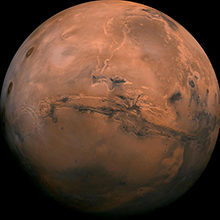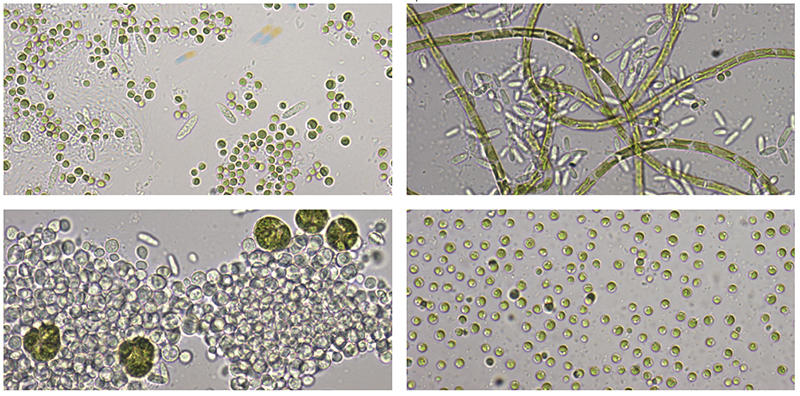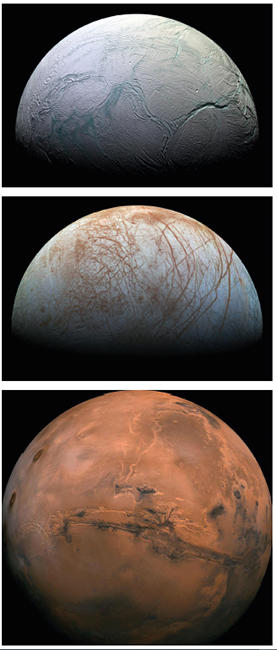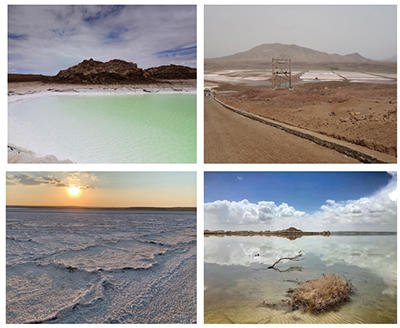New frontiers in microbiology
Issue: Why Microbiology Matters
05 May 2020 article

As we have progressed through the 21st century, we have expanded and developed our understanding of how microbes are related to and interact with each other. This section considers the ever-growing tree of life, how we can study complex microbial communities to gain new insights and the possibility of discovering life on other planets.
The ever-growing tree of life
Bryn McCulloch and Thorsten Allers
Genealogical research can yield some unexpected surprises. The tree of life shows the relationship between all organisms based on their common ancestry. Until 1977, it had two major branches: prokaryotes and eukaryotes. Then Carl Woese suggested that life could be categorised into three fundamental domains: Eukarya, Bacteria and Archaea. Notably, Archaea and Eukarya are more closely related to each another than to Bacteria.
The discovery of new archaeal groups has included DPANN – archaea with extremely small cell and genome sizes that appear to be obligate symbiotes – and Asgard – a recently cultivated group found at deep sea vents. Including Asgard archaea in phylogenetic analyses has uncovered a strong affiliation with eukaryotes, leading to the proposal for a two-domain Tree of Life: this time, the Eukarya branch originates from within the Archaea. In this scenario, eukaryotic cells originated from a symbiosis between an Asgard-like host cell and a proteobacterium, which later became a mitochondrion.
As with any genealogical research, the two-domain versus three-domain tree has been a topic of debate within the scientific community, but new evidence is making a two-domain tree appear more promising. Tom Williams and colleagues at the University of Bristol analysed more than 3,000 gene families in Archaea and Eukaryotes and consistently found Eukaryotes to have originated from within Archaea and that an Asgard lineage called Heimdallarchaeota is the closest archaeal relative to the Eukarya.
The tree of life continues to expand with the discovery of new life. This could come from previously unexplored environments, such as the growing field of astrobiology, but also from the ability to create synthetic life. Expect plenty more unexpected surprises!
Further reading
Imachi H, Nobu MK, Nakahara N, Morono Y, Ogawara M et al. Isolation of an archaeon at the prokaryote–eukaryote interface. Nature 2020;577:519–525. DOI:10.1038/s41586-019-1916-6.
Williams TA, Cymon JC, Foster PG, Szöllősi GJ, Embley TM. Phylogenomics provides robust support for a two-domains tree of life. Nat Ecol Evol 2020;4:138–147. DOI:10.1038/s41559-019-1040-x.

Bryn McCulloch
School of Life Sciences, University of Nottingham, Nottingham NG7 2UH, UK
Bryn McCulloch graduated with a first class BSc (Hons) in Biology at Edge Hill University, working on extremophiles from salterns in Cabo Verde, and is now completing a master’s in Thorsten Allers’ lab, working on growth conditions of Archaea and the corresponding effects on DNA repair and replication.

Thorsten Allers
School of Life Sciences, University of Nottingham, Nottingham NG7 2UH, UK
After a PhD at the University of Edinburgh and a postdoctoral fellowship at the National Institutes of Health (NIH), USA, Thorsten Allers was awarded a Royal Society University Research Fellowship to establish his laboratory at the University of Nottingham. His group uses the model species Haloferax volcanii to study the genetics of DNA replication, repair and recombination in Archaea.
Why does microbiology matter?
Thorsten: Microbiology with model species helps us to understand the rules of life and where we come from. We were all microbes once upon a time!
How did you enter this field?
Thorsten: I have always worked on micro-organisms; I did my PhD with the bacterium Escherichia coli, my postdoc with the eukaryote Saccharomyces cerevisiae, and my own research group works on the archaeon Haloferax volcanii.
Microalgae, bacteria and vitamins: three key players in aquatic microbial communities
Andre Holzer, Shelby Newsad, Nhan-An Tran, Ellen Harrison and Alison Smith
Micro-organisms are ubiquitous and form complex communities whenever they inhabit the same environment. Well-known examples of microbial communities include the human gut microbiome, but equally important to life on the planet are those in the aquatic environment. These are made up of photosynthetic algae and bacteria as well as many other protists, and are responsible for 50% of global carbon fixation. However, it is only recently that modern sequencing-based approaches have opened up the possibility of studying these aquatic microbial communities and their metabolic dependencies in exquisite detail.
Evolution of life began in the aquatic environment and so too did the formation of microbial communities. Today, diverse groups of microbes are found in every ocean and continent, ranging from temperate to extreme environments, and encompass members from all kingdoms of life (bacteria, archaea, protists and fungi). Whilst every teaspoon of seawater is filled with millions of these organisms, entangled in complex networks of interactions, from mutualistic to commensal (neutral) to parasitic, each community’s composition is unique to the environment in which it lives. Understanding these microbial communities is of major importance, as they form the base of the ocean’s food web, and their metabolic interplay is responsible for approximately 50% of total global carbon fixation.
What shapes these communities?
Open water communities of microbes are shaped by a patchy distribution of nutrients and other abiotic factors such as temperature and salinity. Research into aquatic microbial communities has highlighted the importance of nutrient availability in determining microbial community dynamics in both the freshwater and marine environments. Besides the major inorganic macro- and micro-nutrients such as nitrogen, phosphorus and iron, scientists discovered that the availability of many organic micronutrients, or vitamins, co-limits phytoplankton growth and determines its composition. It has been shown that B-vitamins in particular influence community composition, by favouring the succession of some species over others. In fact, research has revealed that many interactions within aquatic microbial communities are underpinned by the exchange of B-vitamins. This is because vitamin B1 (thiamine), vitamin B7 (biotin) and vitamin B12 (cobalamin) are required in different combinations by 60–70% of all microalgae. But what exactly are microalgae and where do algae obtain the vitamins from if they can’t make them themselves?
Microalgae are a diverse group of largely unicellular photosynthetic eukaryotes, and their photosynthetic activity makes them responsible for primary production, which contributes significantly to the carbon fixation capacities of the ocean microbiome. A common misconception about microalgae, however, is that they are completely autotrophic, needing only simple nutrients, sunlight and carbon dioxide (CO2) for growth. But with over half of all microalgae dependent on vitamin B12, which is synthesised only by bacteria, this underlines the importance of metabolic exchange in defining ecological interactions between micro-organisms.

How can microbial communities be studied?
To gain a mechanistic understanding of interactions, it is necessary to break down complex interaction networks by focusing on single model systems that can be co-cultured under controlled laboratory conditions. Direct demonstration of vitamin exchange came from studies with Ostreococcus tauri, an important picoeukaryotic microalga in oligotrophic waters, which has been shown to require B12 and B1, and the bacterium Dinoroseobacter shibae, which requires vitamins B3, B7 and a precursor of B9 for growth. The microalgae and bacteria can support each other’s growth while in co-culture in the laboratory in a stable mutualism by fulfilling the vitamin requirements of the other species. Other studies of environmental samples looking at 16S rRNA gene sequences found that the Rhodobacteraceae family of bacteria, of which D. shibae is one example, are often found to co-occur with microalgae, suggesting that vitamins shape microbial interactions in the aquatic environment.
Recent advances in next-generation sequencing provide much more extensive possibilities to study interactions within microbial communities by identifying the entire metabolic capability present in an environment. One of the most important large-scale attempts applying such a strategy has been Tara Oceans. “The largest DNA sequencing effort ever done on ocean science” (Patrick Wincker, Genoscope, France) allowed identification of species in various communities and resulted in an extension of the tree of life by more than 30,000 species. With around 40 million mostly novel genes identified in the marine environment, this study provides a key resource that is now available to investigate species interactions in diverse aquatic communities by looking at co-occurrence of organisms in combination with their metabolic abilities.
How can this knowledge be used?
As sequencing data becomes more readily available and species identification of microbial communities improves, it is now possible to infer more complex interactions and further investigate the importance of abiotic factors such as vitamins in regulating communities. Nutrient requirements can be inferred from the genetic or transcriptomic information and interactions can be tested in laboratory settings, experimentally validating co-occurring, metabolically compatible species. Increasingly, gene expression profiles can be generated to look for significant changes in the nutrient dependencies of microbes in different environmental conditions. This will be of great importance as climate change will continue to alter the pattern of nutrients in the ocean and so will change the species that can occur, especially with regards to the formation of harmful algal blooms.
Besides advancing our understanding of aquatic ecology, insights into microbial communities are key for a range of biotechnological applications. Industrial production of microalgae for feed and food applications or production of high-value compounds is often challenged by contamination issues. These may be overcome by the use of designed microbial consortia rather than using monocultures, since the former are likely to be more resistant to contamination. Moreover, vitamins have been shown to repress gene expression in microalgae, by both vitamin-responsive promoters and riboswitches. These genetic elements have the potential to be added to the synthetic biology toolkit, to engineer strains with more targeted production of high-value compounds. In future, we look forward to more breakthroughs, to move on from metabolic fitting to understanding more complex regulatory dynamics in both industrial and natural microbial communities.
Further reading
Kazamia E, Helliwell KE, Purton S, Smith AG. How mutualisms arise in phytoplankton communities: building eco-evolutionary principles for aquatic microbes. Ecol Lett 2016;19:810-822.

Andre Holzer
Department of Plant Sciences, University of Cambridge, Cambridge CB2 3EA, UK
[email protected]
@AndreHolzer
plantsci.cam.ac.uk/directory/holzer-andre
Andre Holzer is a Gates Cambridge Scholar and PhD candidate. Andre completed a BSc degree in Molecular Biotechnology before he focused on computational biology during his MSc. After graduating from Heidelberg University in 2017, he started his PhD at Cambridge, where his research is investigating open questions in the evolution of B-vitamin dependencies and microbial interactions by applying multi-omics approaches. In parallel, he is co-leader of the citizen science project PuntSeq (puntseq.co.uk) which is employing novel real-time DNA sequencing to monitor microbial composition of freshwater sources.

Shelby Newsad
Department of Plant Sciences, University of Cambridge, Cambridge CB2 3EA, UK
[email protected]
plantsci.cam.ac.uk/directory/newsad-shelby
Shelby Newsad is a Cambridge Trust Scholar and PhD candidate. Shelby graduated from Ohio State University with a BS in Biochemistry. After graduation, she worked at the National Institutes of Health, then undertook an MPhil in Bioscience Enterprise where she decided to refocus her research efforts on sustainable systems. Shelby started her PhD at Cambridge in 2018 with her project investigating vitamin-dependent gene regulation and algae–bacteria symbioses.

Nhan-An Tran
Department of Plant Sciences, University of Cambridge, Cambridge CB2 3EA, UK
[email protected]
plantsci.cam.ac.uk/directory/tran-an
Nhan-An Tran is a Cambridge Trust Scholar and PhD candidate. Nhan-An completed a BSc in Marine Biology with Honours in Environmental Science at the University of Technology, Sydney. She started her PhD in Plant Sciences at the University of Cambridge in 2019, where her research focuses on exploring the interactions between microalgae and bacteria to improve large-scale microalgal production systems.

Ellen Harrison
Department of Plant Sciences, University of Cambridge, Cambridge CB2 3EA, UK
[email protected]
plantsci.cam.ac.uk/directory/harrison-ellen
Ellen Harrison is MELiSSA POMP II PhD Candidate. Ellen graduated from the University of St Andrews with a BSc in Marine Biology. Then she completed an MRes at the University of Plymouth in association with the Marine Biological Association, investigating nutrient sensing in diatoms. Ellen started her PhD in 2018, investigating how bacteria and algae in co-culture can provide vitamin B12 for human consumption on long space missions.

Alison Smith
Department of Plant Sciences, University of Cambridge, Cambridge CB2 3EA, UK
[email protected]
plantsci.cam.ac.uk/directory/smith-alison
Alison Smith is Professor of Plant Biochemistry. After studying Biochemistry at the University of Bristol, and then a PhD followed by a postdoc at Cambridge, Alison Smith was appointed to the academic staff in the Department of Plant Sciences in Cambridge, where she has been a Professor since 2007. Her research interests are understanding algal metabolism to facilitate exploitation of these organisms for food/feed, waste remediation and production of high-value compounds.
Why does microbiology matter?
Joint answer: Micro-organisms are invisible to our eyes but essential for all life on Earth. By studying micro-organisms, the field of microbiology helps us understand how life on our planet evolved, how health of single species, including humans, can be maintained as well as how whole ecosystems are shaped. Besides this, the field of microbiology has made significant contributions to many fundamental questions in molecular biology and allows industrial use of micro-organisms for biotechnological applications, including the production of high-value compounds like pharmaceuticals.
What is the most rewarding part of your job?
Joint answer: Multidisciplinary teamwork is the most rewarding part of the job. Like bacteria and algae living and working together, our collaborations and joint projects make science fun and exciting. Just as the organisms we study do not live in a silo – we do not work alone and depend on each other for different knowledge and expertise. Though we don’t exchange vitamins, sometimes help forming a hypothesis or seeing your data from a different angle can be just as valuable.
Bugs in space: astrobiology and the search for life outside our planet
André Antunes

Are we alone in the universe? This question has haunted our minds and imaginations since the dawn of mankind and is arguably one of the final frontiers of science. Microbiology is bringing us closer than ever to finally getting an answer. The search for life outside our own planet is the object of astrobiology – a relatively recent cross-disciplinary research field bringing together bio-, geo- and planetary scientists, which is heavily linked with microbiology and the study of extreme environments.
From canals to exooceans
The dry and barren landscape of the Martian surface shown by the Viking Lander missions in the 1970s is contrasted with the romantic views of canals across its surface envisioned by Percival Lowell in the late 1800s. As part of the enthusiasm for exploring other planets was fueled by the expectation of finding little green men, public interest fizzled. Later, the end of the Space Race eventually reduced the rate of new space exploration missions and findings.
The wheels have turned once again, and we are currently witnessing a new wave of missions. The last few years have seen renewed interest in the search for extraterrestrial life in our Solar System. On one side, we now have a better understanding of the limits for life and its uncanny resilience on our own planet, and also a better knowledge of the conditions on other planets and moons.
The presence of liquid water – which is seen as an essential condition for life to exist – is now seen as certain for Mars and for a few of the icy moons of the outer solar system which seemingly have global-scale, salty (exo)oceans larger than the ones on Earth (Fig. 1). Surprisingly, Enceladus (and possibly Europa) appear to have hydrothermal activity, with geyser-like seawater projecting into outer space, which will facilitate their study.
Terrestrial analogue sites
Despite increased technical capabilities and increased interest in retrieving samples from other bodies of our solar system for astrobiological studies, we are still years away from reaching this milestone. For the time being, our ability to study the feasibility of life’s existence outside our planet is anchored on research that is done on terrestrial samples.
The search for life’s limits is obviously linked with the exploration of the microbiology of different types of extremes on our own planet. The harsh conditions present on the aforementioned celestial bodies, which were once seen as impeditive for life, are not very different from some extreme environments on Earth which are teeming with microbes.
The comparison and extrapolation of these results are particularly useful when the conditions of the selected terrestrial environment more closely match conditions present on other parts of our solar system. Such environments, which include a wide range of locations across the globe (from deserts, to polar regions and deep-sea locations), are thus used as terrestrial analogues (Fig. 2).
Planetary protection
The increased likelihood of finding evidence of life on other parts of our solar system brings increased concerns when planning space missions. Given that several microbes have been reported as being able to survive space travel, we need to make sure that control measures are adequate to prevent contamination of other planets with terrestrial microbes (forward contamination). Such microbial hitchhikers could seriously compromise experiments looking for evidence of life (providing false positives) and their proliferation under hospitable conditions might lead to the collapse of entire alien ecosystems before we even know that they are there. Likewise, future sample-return missions also need to take into consideration mitigation measures of the potential risks associated with bringing over potential extraterrestrial microbes (backward contamination).
The discussion of these issues – normally referred to as ‘planetary protection’ – is a hot topic and involves regular collaborative efforts and discussions between all major space agencies.
Studies in astrobiology
Research in astrobiology is heavily anchored on the study of extremophiles. Several studies also focus on the survival of microbes during space travel or in conditions on other planets. We have seen considerable efforts in testing different types of microbes in exposure experiments (e.g. simulation chambers, high-atmosphere conditions or even outer-space) and in impact experiments. Results from this research hint at possible interplanetary transfer of microbes and likely survival of microbes on other planets.
The search for biosignatures – traces of biological activity of past or present life on Earth and elsewhere – is also a vital area of research. The distinction between biotic and abiotic is not as easy as it might seem, and long-term preservation of biosignatures can also prove problematic. However, these will be essential when analysing rocks, water or gases from other planets.

Astromycology and astrovirology
In addition to the ongoing effort to study bacteria and archaea within the context of astrobiology, the two most recent topics in this field revolve around fungi and viruses.
Several fungi are known to be incredibly sturdy or even to thrive under extreme settings. Fungi are frequently seen as either a blessing or a curse in the biology of space. On one side, their wide range of applications is vital for future breakthroughs in space biotechnology and even in supporting future manned missions. On the other side, controlling the proliferation of mould across surfaces of the International Space Station is a major and costly issue, due to its quick proliferation and detrimental effect on several types of materials.
At the edge of life, viruses are biological entities which are much simpler and more resilient than cells (which they largely outnumber). Some studies hypothesise that they might have been an early form of life, with critical relevance in the origin and evolution of life. They have been found to thrive in many extreme environments, including several astrobiologically relevant ones. Despite this, their role as potential biosignatures remains mostly unexplored.
Conclusions
Astrobiology is an exciting new field of research and one of the newest frontiers of microbiology. We are slowly starting to lift the veil from these amazing new worlds and opening a new age of major breakthroughs and discoveries.
Further reading
Merino N, Aronson HS, Bojanova DP, Feyhl-Buska J, Wong ML et al. Living at the extremes: extremophiles and the limits of life in a planetary context. Front Microbiol 2019;10:780. DOI:10.3389/fmicb.2019.00780.
Moissl-Eichinger C, Cockell C, Rettberg P. Venturing into new realms? Microorganisms in space. FEMS Microbiol Rev 2016:40:722–737. DOI:10.1093/femsre/fuw015.
Preston LJ, Dartnell LR. Planetary habitability: lessons learned from terrestrial analogues. Int J Astrobiol 2014;13:81–98. DOI:10.1017/S1473550413000396.
Rettberg P, Antunes A, Brucato J, Cabezas P, Collins G et al. Biological contamination prevention for outer solar system moons of astrobiological interest: what do we need to know? Astrobiology 2019;19:951-974. DOI:10.1089/ast.2018.1996.

André Antunes
State Key Laboratory of Lunar and Planetary Sciences, Macau University of Science and Technology (MUST), Taipa, Macau SAR, China
[email protected]
researchgate.net/profile/Andre_Antunes4
André Antunes is an Associate Professor and team leader of astrobiology at China’s State Key Laboratory of Lunar and Planetary Sciences at Macau University of Science and Technology (MUST). He is an expert in microbiology of extreme environments, having specialised in deep-sea and high-salinity locations.
Why does microbiology matter?
We live in a microbial world! Microbes rule our planet, conditioning global geochemical cycles and sustaining all other life-forms, and rule our bodies, where they outnumber our own cells. They are increasingly seen as the solution to major issues that we face by helping us to feed, heal and fuel the world. Microbiology is also increasingly relevant in helping us to find whether we are alone in the universe or not. Microbiology is connected with pretty much everything that surrounds us, and we’ve only just started to scratch the surface of how amazing microbes are and the full scale of their impact.
What are the most important skills you need for your current role?
Passion, perseverance, curiosity and flexibility. I think this is valid for any field of research: you need to love what you do, be naturally curious and follow the opportunities that come along. Being a good communicator (and a good listener) also take you a long way!
Images:
Thumbnail: NASA.
Images of algae communities from the Antarctic. Monika Krolikowski
Enceladus, a moon of Saturn (top), Europa, a moon of Jupiter (middle) and Mars (bottom) are currently the main targets for the search of life outside our planet. NASA.
Examples of terrestrial analogue sites. Top left, Qaidam, China; top right, Pedra de Lume, Cape Verde; bottom left, Lake Tirez, Spain; bottom right, Qaidam, China. A. Antunes, X. Yi.
